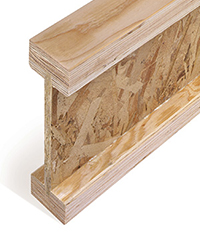We’d like to remind Forumites to please avoid political debate on the Forum.
This is to keep it a safe and useful space for MoneySaving discussions. Threads that are – or become – political in nature may be removed in line with the Forum’s rules. Thank you for your understanding.
📨 Have you signed up to the Forum's new Email Digest yet? Get a selection of trending threads sent straight to your inbox daily, weekly or monthly!
Flooring a roofspace
Comments
-
Money_Grabber13579 wrote: »The strength of the floor is something i’ve been thinking about as I definitely don’t want the whole thing to come crashing down! Is there an easy way to find out what the load bearing capacity of the joists would be or is that something which can only be determined through many years experience? The house is about 8 years old and the joists are approx 30cm apart (I guess the grade of the joists would also be important but i’d have to go and measure that)
I got a structural engineer in to advise me (he also advised on other things, and was money well spent). From what I have learned, newer houses often are not built to take heavy internal loads in the attic. There have been a few threads on this, and the dangers of incorrect methods of "strengthening" the attic floor.(Nearly) dunroving0 -
Definitely need to think about the weight issue. I don’t intend on storing significantly heavy objects up there but appreciate that a number of small things could still constitute a heavy load for the roof timbers. I’ll need to do some more research before committing to anything, I think...Northern Ireland club member No 382 :j0
-
Money_Grabber13579 wrote: »Definitely need to think about the weight issue. I don’t intend on storing significantly heavy objects up there but appreciate that a number of small things could still constitute a heavy load for the roof timbers. I’ll need to do some more research before committing to anything, I think...
If you have concerns, one strategy is to load heavier things above load-bearing walls.(Nearly) dunroving0 -
If you have concerns, one strategy is to load heavier things above load-bearing walls.
I think the only load bearing walls I have are the outer walls of the house. I do have a solid wall between the hall and the lounge/kitchen but don’t think it extends to upstairs and I think all the internal walls upstairs are stud walls (so any weight is going to be borne by the roof timbers and passed to the outer walls).
So, I guess the question is just how strong the roof timbers are...
I have a small section around the hatch floored already and have quite a bit of stuff up there, but don’t think trial and error is how I want to proceed when determineing how much weight it can take!Northern Ireland club member No 382 :j0 -
The way I did it was to increase the depth of the ceiling joists to a minimum of 12" (it's a very old house so nothing is level, evenly spaced, or square). To do this I essentially fabricated engineered joists in situ. This provided adequate strength to support the floor and also allowed me to lay insulation in the space between the attic floor and the ceiling below.
Engineered joist...
Googling "joist calculations" should give you something to work with.0 -
Ok, so not to set aside the weight considerations (which i’ll look at separately), would something like this be a suitable flooring product?
https://eglantinetimber.com/product/osb-loft-board/
It comes in 2.44m lengths but seems to be in 20cm widths rather than 60cm widths, so should be easier to get into the roofspace.Northern Ireland club member No 382 :j0 -
Money_Grabber13579 wrote: »Ok, so not to set aside the weight considerations (which i’ll look at separately), would something like this be a suitable flooring product?
https://eglantinetimber.com/product/osb-loft-board/
It comes in 2.44m lengths but seems to be in 20cm widths rather than 60cm widths, so should be easier to get into the roofspace.
Those boards are 600mm wide. You have to be certain the joists in the loft will take the weight of the loft boards and the weight of the stuff your putting on them, otherwise you will find all the plaster on your ceilings cracking. You can place stuff where there are walls below, the ceiling will not flex here.0 -
Those boards are 600mm wide. You have to be certain the joists in the loft will take the weight of the loft boards and the weight of the stuff your putting on them, otherwise you will find all the plaster on your ceilings cracking. You can place stuff where there are walls below, the ceiling will not flex here.
I boarded my loft with plywood as it lighter for the same strength.
I used the largest pieces that I could fit through the hatch.
https://www.wickes.co.uk/Wickes-Non-Structural-Hardwood-Plywood---12mm-x-606mm-x-1220mm/p/1104010 -
The disadvantage of ply is no T&G - so you choose to have unsupported ends or always have to cut/join on the top of joists, or add noggins.
I find the smaller T&G boards easy to lay, especially single handed.0 -
Mr.Generous wrote: »Much smaller packs of 18mm chip are available, something like 1200 x 450, a 3 pack costs about the same as a big sheet but is so much easier to handle and fit through the hatch. I'd put a couple of lights up too if you are boarding it out.
We bought a 5ft, twin LED strip light for our loft, think it was about £40, its brilliant0
This discussion has been closed.
Confirm your email address to Create Threads and Reply

Categories
- All Categories
- 351.7K Banking & Borrowing
- 253.4K Reduce Debt & Boost Income
- 454K Spending & Discounts
- 244.7K Work, Benefits & Business
- 600.1K Mortgages, Homes & Bills
- 177.3K Life & Family
- 258.4K Travel & Transport
- 1.5M Hobbies & Leisure
- 16.2K Discuss & Feedback
- 37.6K Read-Only Boards





